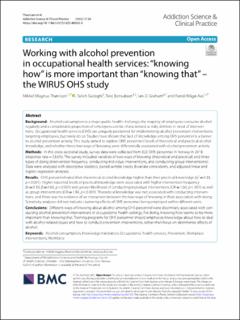| dc.contributor.author | Thørrisen, Mikkel Magnus | |
| dc.contributor.author | Sadeghi, Talieh | |
| dc.contributor.author | Bonsaksen, Tore | |
| dc.contributor.author | Graham, Ian D. | |
| dc.contributor.author | Aas, Randi Wågø | |
| dc.date.accessioned | 2022-11-11T09:12:11Z | |
| dc.date.available | 2022-11-11T09:12:11Z | |
| dc.date.created | 2022-09-12T19:18:57Z | |
| dc.date.issued | 2022 | |
| dc.identifier.issn | 1940-0632 | |
| dc.identifier.uri | https://hdl.handle.net/11250/3031334 | |
| dc.description | Open Access This article is licensed under a Creative Commons Attribution 4.0 International License, which
permits use, sharing, adaptation, distribution and reproduction in any medium or format, as long as you give appropriate credit to the original author(s) and the source, provide a link to the Creative Commons licence, and indicate if changes were made. The images or other third party material in this article are included in the article’s Creative Commons licence, unless indicated otherwise in a credit line to the material. If material is not included in the article’s Creative Commons licence and your intended use is not permitted by statutory regulation or exceeds the permitted use, you will need to obtain permission directly from the copyright holder. To view a copy of this licence. | en_US |
| dc.description.abstract | BACKGROUND: Alcohol consumption is a major public health challenge; the majority of employees consume alcohol regularly and a considerable proportion of employees can be characterized as risky drinkers in need of interventions. Occupational health services (OHS) are uniquely positioned for implementing alcohol prevention interventions targeting employees, but rarely do so. Studies have shown that lack of knowledge among OHS personnel is a barrier to alcohol prevention activity. This study aimed to explore OHS personnels' levels of theoretical and practical alcohol knowledge, and whether these two ways of knowing were differentially associated with alcohol prevention activity. METHODS: In this cross-sectional study, survey data were collected from 322 OHS personnel in Norway in 2018 (response rate=53.6%). The survey included variables of two ways of knowing (theoretical and practical) and three types of doing (intervention frequency, conducting individual interventions, and conducting group interventions). Data were analyzed with descriptive statistics, paired sample t-tests, bivariate correlations, and adjusted linear and logistic regression analyses. RESULTS: OHS personnel rated their theoretical alcohol knowledge higher than their practical knowledge (η2=0.33, p<0.001). Higher reported levels of practical knowledge were associated with higher intervention frequency (b=0.39, β=0.60, p<0.001) and greater likelihood of conducting individual interventions (OR=1.60, p<.001) as well as group interventions (OR=1.84, p<0.001). Theoretical knowledge was not associated with conducting interventions, and there was no evidence of an interaction between the two ways of knowing in their association with doing. Sensitivity analyses did not indicate clustering effects of OHS personnel being employed within different units. CONCLUSIONS: Different ways of knowing about alcohol among OHS personnel were dissimilarly associated with conducting alcohol prevention interventions in occupational health settings. For doing, knowing how seems to be more important than knowing that. Training programs for OHS personnel should emphasize knowledge about how to deal with alcohol-related issues and how to conduct prevention interventions, rather than focus on detrimental effects of alcohol. | en_US |
| dc.language.iso | eng | en_US |
| dc.relation.uri | https://rdcu.be/cWJTX | |
| dc.rights | Navngivelse 4.0 Internasjonal | * |
| dc.rights.uri | http://creativecommons.org/licenses/by/4.0/deed.no | * |
| dc.title | Working with alcohol prevention in occupational health services: "Knowing how" is more important than "knowing that" - the WIRUS OHS study | en_US |
| dc.title.alternative | Working with alcohol prevention in occupational health services: "Knowing how" is more important than "knowing that" - the WIRUS OHS study | en_US |
| dc.type | Peer reviewed | en_US |
| dc.type | Journal article | en_US |
| dc.description.version | publishedVersion | en_US |
| dc.rights.holder | © The Author(s) 2022 | en_US |
| dc.source.volume | 17 | en_US |
| dc.source.journal | Addiction science & clinical practice | en_US |
| dc.source.issue | 1 | en_US |
| dc.identifier.doi | 10.1186/s13722-022-00335-0 | |
| dc.identifier.cristin | 2050989 | |
| dc.relation.project | Universitetet i Stavanger: IN-11551 | en_US |
| dc.relation.project | Norges forskningsråd: 260640 | en_US |
| cristin.ispublished | true | |
| cristin.fulltext | original | |
| cristin.qualitycode | 1 | |

